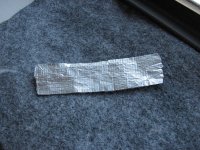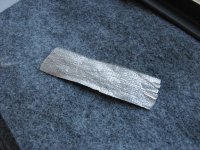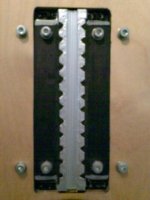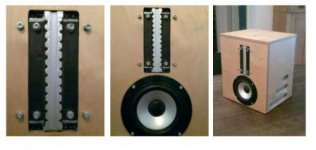NV&H,
Would you be willing to add another couple of thou of a gram in mass? In a pattern applied to just across the short distance on the ends? Testing isn't necessary, but I would be interested in comments about any audible changes you find. You would be able to remove thematerial without harming the ribbon, of course.
Bud
Would you be willing to add another couple of thou of a gram in mass? In a pattern applied to just across the short distance on the ends? Testing isn't necessary, but I would be interested in comments about any audible changes you find. You would be able to remove thematerial without harming the ribbon, of course.
Bud
In a pattern applied to just across the short distance on the ends
Hi Bud,
do you mean your EnABL pattern?
Very interesting. I want to try that with a Quad Esl-63 panel.
Regards,
Harry
NV&H,
Would you be willing to add another couple of thou of a gram in mass? In a pattern applied to just across the short distance on the ends? Testing isn't necessary, but I would be interested in comments about any audible changes you find. You would be able to remove thematerial without harming the ribbon, of course.
Bud
Well, it's not that easy. I have a large volume (2"x2"x1") of >1T flux with 2"x1" openings on two of the six sides. The other 4 sides are magnets. How I've done that in a small package is a secret for now. But my objective is stuff this volume with many folds, ala Heil, but with a different objective. I want good dispersion up high and I what to cover a wide freq range. As I previously hinted at, the ribbon sees constant flux no matter how much it moves. Excursion is limited only by adjacent ribbon folds. To make this even more complicated, the way I'm folding the ribbon, it will be a defacto compression driver, which I will horn load. Crazy sounding, I know.
NV&H
Aah, I thought perhaps you had access to the front of a test unit. I was going to suggest toothpaste and a wooden toothpick, to apply the pattern with, just to see if it helps with the emission coherence.
harry_at
I recently applied a set of pattern blocks to the side frames of a maggie 2.6 R with great success. Did not actually touch the membrane, as that was quite good enough already. Instead I put the patterns up the wooden perimeter sides. Doing so removed all of the notorious maggie mid range triple note and high frequency smear, in the perceived sound field. Also provided a solid center illusion and a very deep bass actually attached to the rest of the musical signal.
Look here to read about it if it interests you to.
http://www.diyaudio.com/forums/planars-exotics/148963-magneplanars-enabl.html
This is certainly the direction I would head in first, if I were going to treat Quads. I would even go so far as to add side pieces to allow a pattern placement there, rather than on the diaphragm itself. I am sure a direct diaphragm application can be done and would be successful, but based on the maggie experiment, I doubt that the diaphragm is the biggest problem to solve.
Bud
Aah, I thought perhaps you had access to the front of a test unit. I was going to suggest toothpaste and a wooden toothpick, to apply the pattern with, just to see if it helps with the emission coherence.
harry_at
I recently applied a set of pattern blocks to the side frames of a maggie 2.6 R with great success. Did not actually touch the membrane, as that was quite good enough already. Instead I put the patterns up the wooden perimeter sides. Doing so removed all of the notorious maggie mid range triple note and high frequency smear, in the perceived sound field. Also provided a solid center illusion and a very deep bass actually attached to the rest of the musical signal.
Look here to read about it if it interests you to.
http://www.diyaudio.com/forums/planars-exotics/148963-magneplanars-enabl.html
This is certainly the direction I would head in first, if I were going to treat Quads. I would even go so far as to add side pieces to allow a pattern placement there, rather than on the diaphragm itself. I am sure a direct diaphragm application can be done and would be successful, but based on the maggie experiment, I doubt that the diaphragm is the biggest problem to solve.
Bud
This is certainly the direction I would head in first, if I were going to treat Quads. I would even go so far as to add side pieces to allow a pattern placement there, rather than on the diaphragm itself. I am sure a direct diaphragm application can be done and would be successful, but based on the maggie experiment, I doubt that the diaphragm is the biggest problem to solve.
Hi Bud,
what I don't like in the Esl-63 panels is the damping mesh which is very, very close to the diaphragm. IMHO, it damps the panel to death. I want to eliminate this mesh and try instead some silicone dots to split up the resonance peak into two or three lower peaks. I have found points on the diaphragm which will do this. Some damping will still be necessary, also maybe for the correct functioning of the delay rings. So I'm curious if the enABL pattern will be helpful for this.
Basically it is no problem for me to try the pattern on a diaphragm. I can repair Esl-63 panels (with the helping 'hand' of a stretching jig and an oven for the heat treatment).
1. Number, size and location of blocks:
The circumference of the rectangular diaphragm is 151,4cm (= 59,6inch). I have the block size calculator from Alex. Normally 18 block pairs are needed, applied one block depth from the edge. But I can apply the pattern on the two short and on one of the long sides only (because close to one of the longer sides are most of the higher frequencies generated).
2. Paint:
At the moment I'm using a 3 µm film. How thick should the paint be applied? Maybe some acrylic paint used for painting on windows - think such a paint should adhere to Mylar?
Or clear packaging tape? Maybe the mass of this is to high, but a precise application would be possible.
Thank you for your help,
Harry
Harry
I intend to start a separate thread for the Quad panels, rather than mess up NV&H's very interesting and specific thread.
http://www.diyaudio.com/forums/planars-exotics/153458-enabl-esl-quad-speakers.html#post1951805
Bud
I intend to start a separate thread for the Quad panels, rather than mess up NV&H's very interesting and specific thread.
http://www.diyaudio.com/forums/planars-exotics/153458-enabl-esl-quad-speakers.html#post1951805
Bud
Last edited:
I first tried corragated ribbon onto the stretched hose, but there was still some extraneous noise. ...
No rattling or buzzing down low (even at 50hz) and the top is smooth as silk.
Hi there,
i had a noise problem with a vertically folded ribbon some years ago.
I solved the problem simply by "chaotically pre wrinkling" before stamping
the folds. No noise anymore. I used a special sole used by shoemakers and
a foam rubber. I rolled the alu foil 30-40 times between rubber and
sole profile thereby using a different angle everytime.
You could hear the foil getting more silent during that preparation
by shaking it between the fingers.
No additional fabric needed, no glue ...
Hi there,
i had a noise problem with a vertically folded ribbon some years ago.
I solved the problem simply by "chaotically pre wrinkling" before stamping
the folds. No noise anymore. I used a special sole used by shoemakers and
a foam rubber. I rolled the alu foil 30-40 times between rubber and
sole profile thereby using a different angle everytime.
You could hear the foil getting more silent during that preparation
by shaking it between the fingers.
No additional fabric needed, no glue ...
I did something similar to that and it did reduce the frequency at which things sounded fuzzy. Lowest I could go was about 600hz. With the hose, it never got fuzzy even at full range. Anyway, as promised, here are the photos. These are of a ribbon segment with one side showing the hose and the other not. This ribbon is silent as the grave.
Attachments
Women's accessories for audio
That looks like an old wrinkled piece of gray Duct tape to me. On the topic of just making sh-t up I know I should Probably should start a new thread but...
You get a similar effect by mounting 3/4 inch domes in the tips of a wonder bra.
You can also mount mid domes the same way using different cup sizes to tune the rear cavity.
Any other ideas using these techniques?
That looks like an old wrinkled piece of gray Duct tape to me. On the topic of just making sh-t up I know I should Probably should start a new thread but...
You get a similar effect by mounting 3/4 inch domes in the tips of a wonder bra.
You can also mount mid domes the same way using different cup sizes to tune the rear cavity.
Any other ideas using these techniques?
I still dont get it
What is it you are doing with that fabric ?
He's gluing very fine flexible netting ("panty hose", as in ladies' stocking material) to the surface of the ribbon to damp the resonances. The "hose" just refers to "panty hose"; see here. It's just a nylon/aluminum composite ribbon. Great idea, though.
Few
As for the primary resonance of the ribbon; that just depends on the tension I put on it. When I pull it tight, frequency rolls off below 1khz. With no tension (i.e., no centering force), the resonant frequency is probably close to 0 hz. Afterall, a spring/mass system with a super weak spring gives a super low resonance. With no tension, I can hear rather deep base.
Interesting...I'm thinking of making a bass panel for an Apogee Caliper Signature and wouldn't mind trying this technique, as it would help in alleviating tuning issues (resonances).
But doesn't pantyhose lose elasticity after a while? Tension wouldn't be that much but still there is some.
No rattling or buzzing down low (even at 50hz) and the top is smooth as pantyhose.
- Status
- This old topic is closed. If you want to reopen this topic, contact a moderator using the "Report Post" button.
- Home
- Loudspeakers
- Planars & Exotics
- Astonishing discovery



